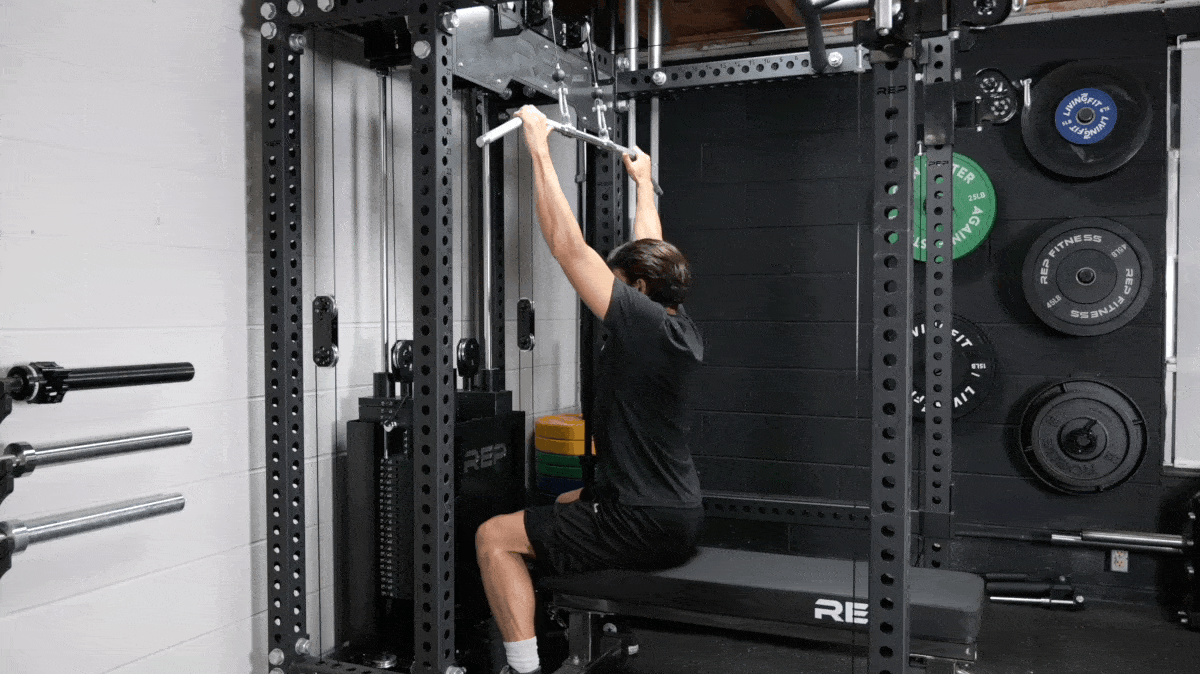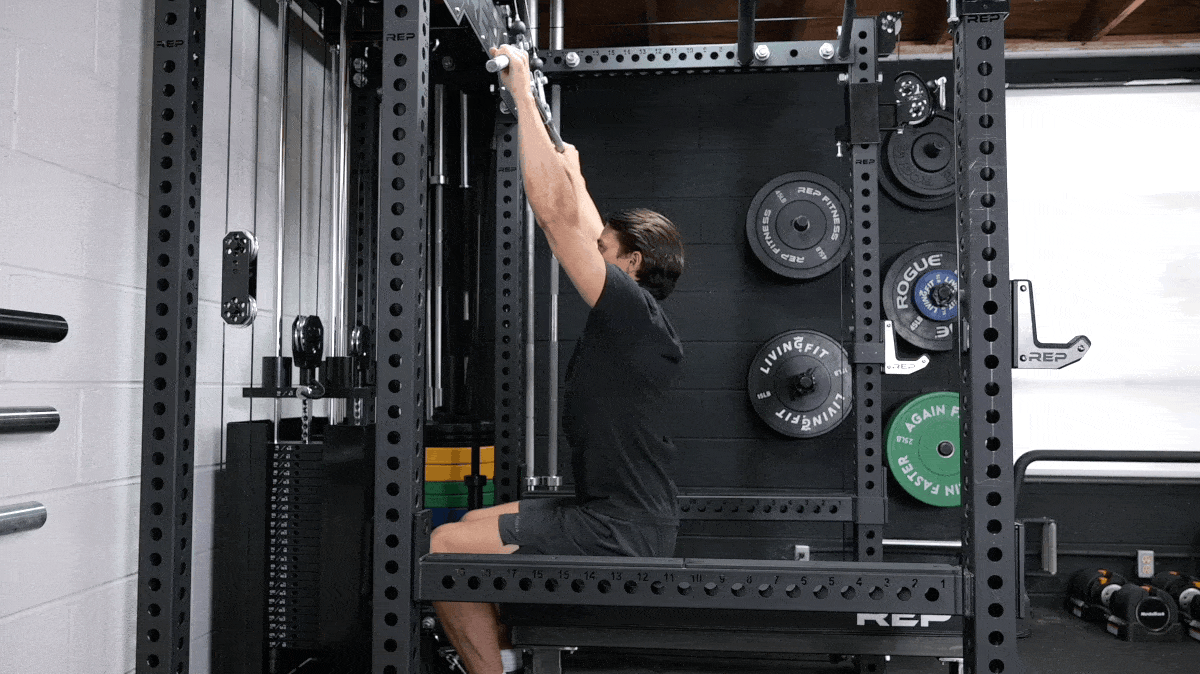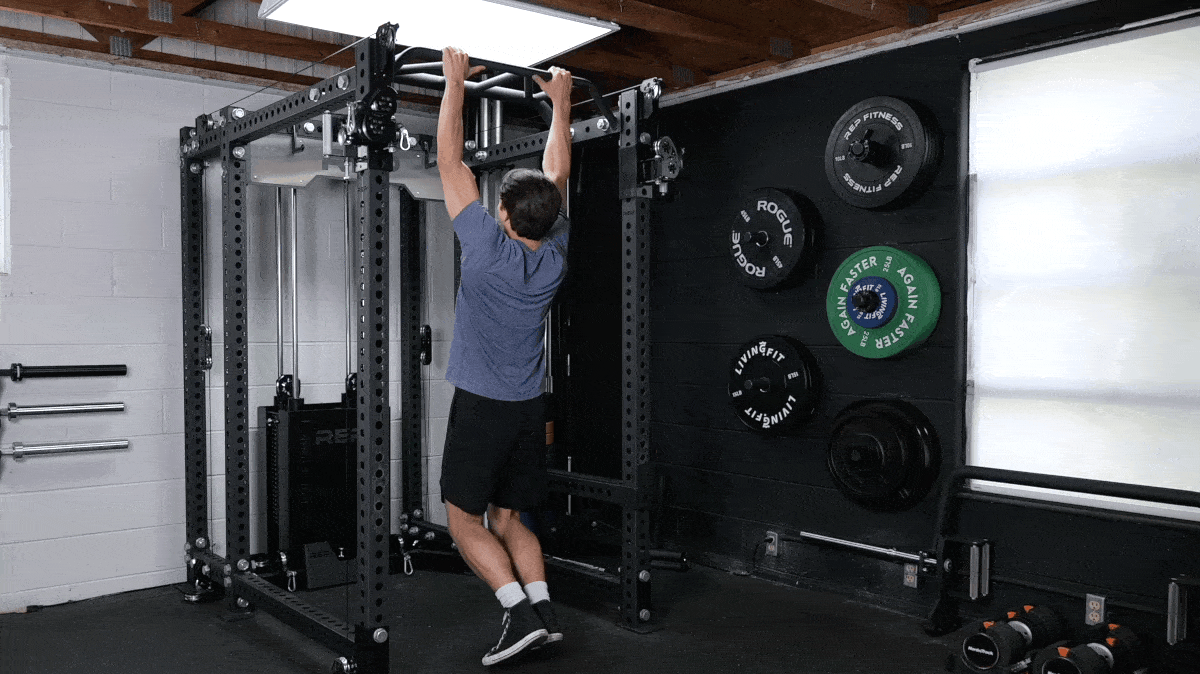As a strength athlete, you may have any number of goals. Sometimes, you want to increase strength. Other times, you’re focused on how to build muscle. Regardless of your goals, you’re going to need to develop a strong back. For this, finely-tuned accessory exercises come in handy to supplement your bigger lifts — read: the deadlift and bent-over row.
The lat pulldown is a compound exercise that will help you forge a stronger, wider back and help you take on your first pull-up. Because it is an overhead pull — performed with cable or a machine — it gives you a unique opportunity to develop your vertical pulling strength without performing a full pull-up.

Even if you can already do strict pull-ups, lifters of all levels can benefit from the muscle-building potential of this accessory move. Get ready to learn everything you need about lat pulldown form and everything it has to offer.
How to Do the Lat Pulldown

- Step 1 — Take a medium-width, double-overhand grip on the bar, a few inches outside the shoulders. Make sure that the bar itself is resting in the middle of the palm, not in the fingertips. You can choose a thumbless grip or you can wrap your thumb around the bar.
- Step 2 — Sit down, making sure that your arms are fully extended and under load when seated to maximize the stretch on the lats. Your feet should be flat on the floor and your thighs situated snugly underneath the leg anchoring pad. Think about flaring your lats out as you reach overhead.
- Step 3 — Sit up as tall as you can, feeling the stretch on the lats and triceps. With your chest up and back arched, pull the bar down to your chin level. As you pull down, try to minimize leaning back. Think about driving your elbows down towards your back pockets.
- Step 4 — Let your arms go back overhead with control. Make sure to feel a big stretch and tension on the lats. Pause in this fully-stretched position, and repeat for more repetitions.
Why Do It: By isolating your back, lat pulldowns also help improve your back hypertrophy because your knees are held down by the pad you put your thighs under.
Equipment Needed: Lat Pulldown Machine and Bar Attachment
Lat Pulldown Variations
There’s rarely only one way to do any given exercise. Use these pulldown variations to maximize your back gains. You can vary any of these variations further by performing a single-arm lat pulldown with any of these grips. A close-grip pulldown can also be done with an underhand grip, as described here.
Wide-Grip Lat Pulldown

[Read More: Fight Collapsing Elbows With These 6 Lat Mobility Drills]
- Perform the wide-grip lat pulldown using the long bar attachment with the bend toward either end.
- Using an overhand grip, grab the bar at the kink on either side, as opposed to the closer grip of a close-grip pulldown.
- Based on comfort and limb length, place your grip anywhere from your pinky to your thumb at the curve.
- Perform the lat pulldown as usual, utilizing this specific grip placement.
Underhand Lat Pulldown
- Use a straight bar attachment to do the underhand or reverse-grip lat pulldown. Choose an underhand grip about shoulder-width apart or closer.
- Utilize the same set-up as your standard lat pulldown; however, keep your shoulders tucked back and down.
- With your shoulders tucked back and down, perform the lat pulldown as normal.
- End each repetition when you feel your shoulders would otherwise move out of this locked-down position. You can do this as a single-arm pulldown, too.
Parallel-Grip Lat Pulldown
[Read More: Close-Grip vs. Wide-Grip in the Lat Pulldown — Differences, Similarities, and Does It Really Matter?]
- For the parallel or neutral-grip lat pulldown, set up at your parallel grip lat pulldown using a unilateral grip version of the station.
- Attach D-handles or other neutral-grip handles.
- Grab a handle for each hand and set up your lat pulldown as normal.
- Pull each repetition alongside your body, keeping your hands neutral for the entire rep.
Straight-Arm Lat Pulldown
- To do a straight-arm pulldown, set up at a single-pulley cable machine with the attachment raised to the highest position.
- Utilize a straight bar or long rope attachment.
- Take a grip about shoulder width (or slightly wider than your body width).
- Hinge at your hips, keep your arms long with a slight bend at your elbow, and contract your lats.
- Sweep your arms alongside your body, controlling the eccentric portion by lowering the weight under control between repetitions.
Lat Pulldown Alternatives
If you do not have access to a lat pulldown, you can use some of the pulldown alternatives below to train your lats and back directly. You may also be able to vary your grips (underhand, wide-grip, neutral) depending on the bar or equipment setup.
Remember as you’re working through these movements that it doesn’t have to be a choice between the lat pulldown versus pull-up. You can use both to improve each other in a positive feedback loop of back development.
Strict Pull-Up

- Grab the pull-up bar with your hands about shoulder-width apart using an overhand grip.
- Stabilize in a dead hang, eliminating any sway and fully bracing your body.
- Start from a dead hang with your shoulders protracted overhead each rep. Initiate by tucking your shoulders back and down.
- Pull using your lats until you reach an eye-to-chin level with the bar. Control your lowering portion and perform for repetitions.
Band-Assisted Pull-up
- Loop a medium tension band around the pull-up bar. It should be taught enough to assist but not so tight that you struggle to stretch the band.
- Grab the bar with your hands shoulder-width apart and an overhand grip.
- Support your body weight with the band by wrapping it underneath your feet. Lower yourself into the normal starting position with the band stretching to assist.
- Perform pull-ups as normal, with a portion of your body weight reduced by the band tension in the lowest part of each rep.
Machine Assisted Pull-up
- Select a weight that subtracts a percentage of your body weight but still allows for a challenge at eight to 12 repetitions.
- Set up on the machine-assisted pull-up station by kneeling on the support pad and assuming an overhand grip.
- Allow your shoulders to relax into a dead hang and brace your full body.
- Perform pull-ups as normal, controlling the lowering portion of each repetition.
Who Should Do the Lat Pulldown
Lat pulldowns can benefit all lifters, regardless of sport or training level. Whether you’re a strength athlete, CrossFitters, or casual gymgoer, you can benefit from having these cable exercises in your program.
- Strength Athletes: From lower lat exercises like the wide-grip lat pulldown and straight-arm pulldown to the more classic variation, you’ll forge the kind of strong back you need to heft heavy weights.
- CrossFitters: Lat pulldowns bars may not be the first-choice equipment of CrossFitters, but they’re still a great choice. The lat pulldown helps set your foundation for kipping pull-ups or muscle-ups without increasing your fatigue and full-body stress.
- Regular Gymgoers: Often, beginner gymgoers and even more seasoned lifters struggle with performing pull-ups or doing them properly. In this case, athletes can use lat pulldowns to flesh out their vertical pulling game.
Lat Pulldown Sets and Reps
- For Muscle Mass: Perform two to four sets of eight 12 repetitions, staying one to two repetitions away from failure. Rest for 90 seconds to two minutes between each set.
- For Strength: Perform two to three sets of six to eight repetitions, with about one to two repetitions still in the tank. Rest for at least two minutes between each set.
- For Endurance: To build the endurance of your grip, lats, and arms, perform three to four sets of 12 to 15 repetitions with about 30 seconds of rest between each set.
Benefits of the Lat Pulldown
The lat pulldown is an excellent addition to lifters’ programs at any level. Whether you’re trying to do your first pull-up or want to build a wider back, consider adding these to your repertoire.
Build Pull-Up Strength
If you want to get better at pull-ups, you need to be doing pull-ups. But if you’re not able to perform one yet — or if you can’t yet perform enough pull-ups to get a high amount of training volume in — you can use the lat pulldown to increase the training volume.
Build a Bigger, Wider Back
With lat pulldowns, you can accumulate a tremendous amount of pulling volume without accumulating nearly as much full-body stress as pull-ups, rows, or other compound back exercises.
Here, you can add significant amounts of training volume and muscle without being limited by pull-up or grip strength. Plus, since your legs are anchored down during the move, you’ll be isolating your back muscles for an added pump.
Improve Your Bracing
A heavy set of lat pulldowns starts to resemble a pull-up in a lot of ways. One thing you’ll notice is your tendency to get really tight to simply eke out the last few reps. Holding your shoulders in the right position, locking in your core, and squeezing your grip as tight as possible becomes more and more mandatory. Practicing this kind of bracing can pay off during bigger lifts.
[Read More: Best Back Exercises and Back Workouts for More Muscle]
Muscles Worked by the Lat Pulldown
The lat pulldown is a back-specific movement that allows you to isolate the lats to a very high degree.
The primary muscles worked in lat pulldowns are going to be in your back. But you may also feel your biceps and forearms kicking in. This is fine — they are secondary movers — but if you feel the movement primarily in your arms instead of your back, you may not be engaging your lats properly.
Instead, you might be compensating with your biceps and forearms. If this is the case, you need to decrease the load and try using a wider grip or thumbless grip.
- Latissimus Dorsi
- Rear Delts
- Traps
- Biceps (secondary)
- Forearms (secondary)
Common Lat Pulldown Mistakes
The lat pulldown is a staple in many programs at almost any stage of training. Common mistakes you’ll want to avoid in any situation are using too much momentum, leaning back too far, or losing range of motion.
Momentum
Momentum is the enemy of muscle contraction. When you start to allow for unintentional body English or large degrees of sway, the tension your muscle could be producing is reduced as a consequence. Your muscles won’t be benefitting as much even if you’re technically finishing each rep. Stay strict here unless you’re deliberately overloading your last couple of reps.
Too Much Lean
The lat pulldown is a vertical pull. One major error that you might come across is leaning way too far back to complete your lat pulldown. While some backward lean is okay (as it helps get your head out of the way of the bar), too much backward shifting will convert your lat pulldown into a row.
As with momentum, if you’re going to lean, do it with intention to bring your set to failure rather than as an accidental part of your “usual” form.
[Read More: The Most Effective Workout Splits, Created by Our Experts]
Lifting Too Heavy
As your set gets close to the end, fatigue is inevitable. You may feel your grip start to burn, your arms get heavy, or your range of motion slip away. Load selection is critical to keep your repetitions in the same range of motion from the first to the last. If you’re lifting too heavy, you’re likely to not bring your reps to full range of motion.
Training the full range of motion makes sure your lats are always working, be diligent about repetition execution and load selection to avoid losing range of motion throughout your set.
Pull it Down
The lat pulldown is a great back isolation exercise to build wider lats and a stronger back. You can perform a wide array of pulldown variations, change grips, and even change angles slightly to customize your back training experience. The lat pulldown can be a beneficial movement for lifters of all levels and a great supplement to pull-ups and other back exercises.
FAQs
Got more questions about lat pulldowns? Read on to figure out everything you ever wanted to know about this crucial back accessory.
Why should I train lat pulldowns?
If you want a bigger, stronger, and more developed back, lat pulldowns can be great for your training. But building a bigger back via pull-ups isn’t accessible to everyone. Lat pull downs will help if you are at all attempting to increase back size and strength without massive fatigue.
Should you do lat pulldowns if you are good at pull ups?
Lat pulldowns are useful for building a bigger, more developed back. With these, your grip or overall strength and fatigue won’t be a limiting factor. Pull-ups are very demanding on the body. While they are great exercises, lat pulldowns may be better when you’re fatigued.
How low should you pull the bar down to you in the last pulldown?
This can vary based on grip width and the individual. However, pulling the bar down to the upper chest is often a good starting point for very new beginners. Some lifters will pull the bar down to their sternum. This can create an excellent contraction if the shoulders do not round forward during the movement. Conversely, some lifters will pull the bar only to their chin, which allows them to lift more weight but may sacrifice range of motion and a better contraction.
Featured Image: martvisionlk / Shutterstock